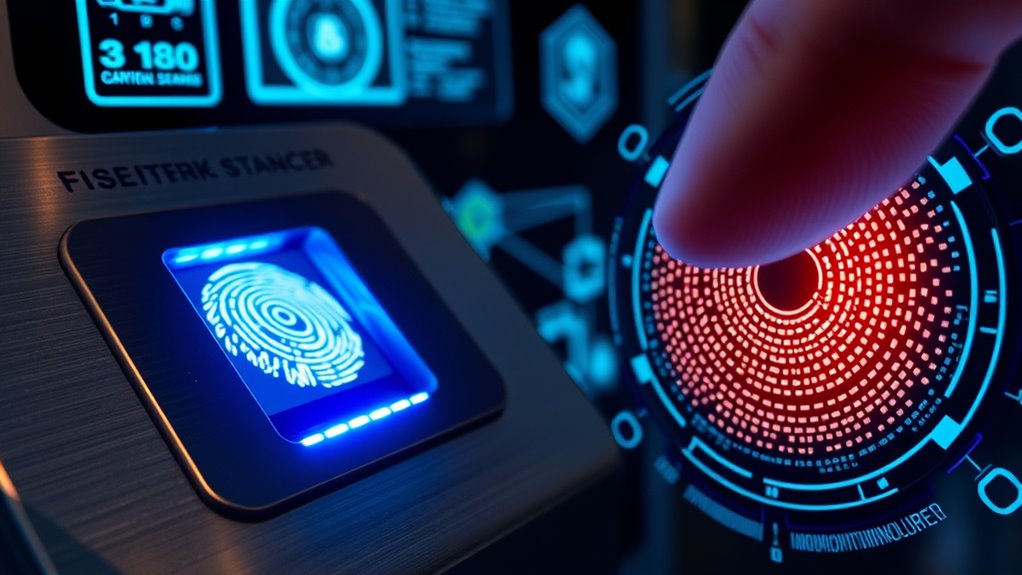Using biometric authentication makes your security stronger by providing quick, convenient access that’s hard to fake. It removes the need to remember passwords and helps protect your digital and physical assets. However, it also comes with risks, like data breaches that can’t be undone and privacy concerns over who has access to your sensitive traits. While it’s a powerful tool, understanding its limits and best practices will help you keep your information safe. Continue to explore how to balance these benefits and risks effectively.
Key Takeaways
- Biometric authentication offers fast, convenient, and secure identity verification, reducing reliance on passwords or physical keys.
- Data breaches can compromise biometric traits permanently, posing long-term security risks.
- Environmental factors and technological limitations can cause false negatives or positives, affecting system reliability.
- Robust security protocols and layered defenses are essential due to increasing industry adoption and potential vulnerabilities.
- Balancing benefits with privacy concerns and understanding system limitations are crucial for informed security use.

Biometric authentication has become an increasingly popular method for securing your digital and physical assets because it offers a fast, convenient, and highly secure way to verify your identity. Instead of remembering passwords or carrying physical keys, you can simply use your fingerprint, face, or iris to gain access. However, despite its advantages, there are important privacy concerns to consider. When you register your biometric data, it’s stored in databases that could be targeted by hackers. If compromised, unlike passwords, biometric traits cannot be changed, raising the risk of identity theft or misuse. You might worry about who has access to this sensitive data and how it’s protected, especially in the case of data breaches or government surveillance. These privacy issues are a significant part of the ongoing debate about the use of biometric systems.
Alongside privacy concerns, technological limitations can affect the reliability of biometric authentication. No system is perfect, and false negatives or positives can occur. For instance, environmental factors like poor lighting, dirt, or injuries can interfere with facial or fingerprint recognition, making it hard for the system to correctly identify you. moreover, some biometric sensors aren’t sophisticated enough to accurately capture unique features, leading to potential errors. These technological limitations can result in frustration or delays when you’re trying to access secure locations or devices. They also pose a security risk if an attacker finds ways to trick or bypass the system, such as using photographs or molds of fingerprints. While advancements are continually improving accuracy, these limitations highlight that biometric systems aren’t infallible and can sometimes be less reliable than traditional methods. Additionally, the growing use of biometric data in various industries increases the importance of establishing robust security protocols to protect this sensitive information.
It’s important to weigh these privacy concerns and technological limitations against the security benefits biometric authentication offers. While it provides a level of convenience and can strengthen security, it’s not without its vulnerabilities. You should be aware that your biometric data is valuable and, if mishandled or compromised, could lead to serious consequences. Additionally, understanding the current technological constraints can help you make informed decisions about when and where to use biometric security measures. As technology advances, many of these limitations will likely diminish, but for now, it’s wise to remain cautious and consider alternative or layered security options. Overall, biometric authentication is a powerful tool, but it’s essential to stay informed about its risks and best practices to protect your privacy and security effectively.
Frequently Asked Questions
Can Biometric Data Be Hacked or Stolen?
Yes, biometric data can be hacked or stolen, especially if inadequate security measures are in place. Hackers may exploit vulnerabilities through methods like cryptographic encryption weaknesses or data breaches. If your biometric data gets compromised, it could lead to serious legal implications, as it’s personal and unique. Always guarantee your biometric information is stored securely with strong encryption, and stay informed about how your data is protected to minimize risks.
What Happens if Biometric Data Is Permanently Compromised?
If your biometric data gets permanently compromised, you can’t change it like a password. This exposes you to ongoing data breach risks, as hackers could misuse your fingerprints or facial data. Recovery procedures involve alerting the affected services, monitoring for misuse, and possibly replacing your biometric credentials with newer data if the system allows. To protect yourself, stay informed about breaches and advocate for strong security measures.
Are There Privacy Concerns With Biometric Data Collection?
Imagine your fingerprint data falling into the wrong hands—privacy implications become serious. You might worry about who owns your biometric data and how it’s used. Yes, there are privacy concerns with biometric data collection, like potential misuse or unauthorized sharing. You should question whether companies truly protect your data or if they could exploit it, raising issues about data ownership and consent that need careful regulation and transparency.
How Reliable Is Biometric Authentication Across Diverse Populations?
Biometric authentication’s reliability can vary across diverse populations due to cultural variations and accuracy challenges. You might find it less effective if biometric features differ widely among users or if certain groups have unique physical characteristics. These variations can lead to false rejections or acceptances, so it’s important to implement multi-factor authentication methods and continuously improve algorithms to guarantee consistent accuracy and security for everyone.
Can Biometric Systems Be Fooled by Fake Fingerprints or Images?
Biometric systems are like vaults with complex locks, but clever intruders can try to pick them. Fake fingerprint countermeasures, such as liveness detection, help prevent spoofing, while advanced facial recognition algorithms combat facial recognition spoofing. However, no system is entirely foolproof. You should stay aware that skilled hackers may still find ways to fool these systems, so combining biometrics with other security measures offers the best protection.
Conclusion
While biometric authentication offers enhanced security, some worry about data breaches. But imagine your fingerprint or face as a unique key that’s nearly impossible to duplicate, giving you peace of mind. Think of it as having a secret handshake only you can perform—making unauthorized access a thing of the past. Embracing this technology means safeguarding your digital world effortlessly, turning security into a seamless part of your daily life.








